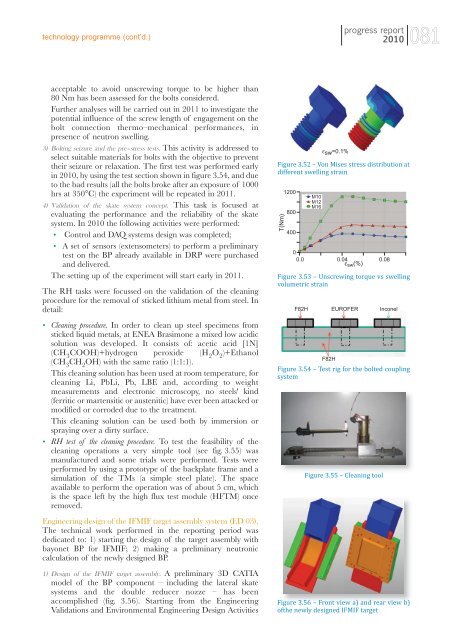Prime pagine RA2010FUS:Copia di Layout 1 - ENEA - Fusione
Prime pagine RA2010FUS:Copia di Layout 1 - ENEA - Fusione
Prime pagine RA2010FUS:Copia di Layout 1 - ENEA - Fusione
You also want an ePaper? Increase the reach of your titles
YUMPU automatically turns print PDFs into web optimized ePapers that Google loves.
technology programme (cont’d.)<br />
progress report<br />
2010<br />
081<br />
acceptable to avoid unscrewing torque to be higher than<br />
80 Nm has been assessed for the bolts considered.<br />
Further analyses will be carried out in 2011 to investigate the<br />
potential influence of the screw length of engagement on the<br />
bolt connection thermo–mechanical performances, in<br />
presence of neutron swelling.<br />
3) Bolting seizure and the pre–stress tests. This activity is addressed to<br />
select suitable materials for bolts with the objective to prevent<br />
their seizure or relaxation. The first test was performed early<br />
in 2010, by using the test section shown in figure 3.54, and due<br />
to the bad results (all the bolts broke after an exposure of 1000<br />
hrs at 350°C) the experiment will be repeated in 2011.<br />
4) Validation of the skate system concept. This task is focused at<br />
evaluating the performance and the reliability of the skate<br />
system. In 2010 the following activities were performed:<br />
• Control and DAQ systems design was completed;<br />
• A set of sensors (extensometers) to perform a preliminary<br />
test on the BP already available in DRP were purchased<br />
and delivered.<br />
The setting up of the experiment will start early in 2011.<br />
The RH tasks were focussed on the validation of the cleaning<br />
procedure for the removal of sticked lithium metal from steel. In<br />
detail:<br />
• Cleaning procedure. In order to clean up steel specimens from<br />
sticked liquid metals, at <strong>ENEA</strong> Brasimone a mixed low aci<strong>di</strong>c<br />
solution was developed. It consists of: acetic acid [1N]<br />
(CH 3<br />
COOH)+hydrogen peroxide (H 2<br />
O 2<br />
)+Ethanol<br />
(CH 3<br />
CH 2<br />
OH) with the same ratio (1:1:1).<br />
This cleaning solution has been used at room temperature, for<br />
cleaning Li, PbLi, Pb, LBE and, accor<strong>di</strong>ng to weight<br />
measurements and electronic microscopy, no steels' kind<br />
(ferritic or martensitic or austenitic) have ever been attacked or<br />
mo<strong>di</strong>fied or corroded due to the treatment.<br />
This cleaning solution can be used both by immersion or<br />
spraying over a <strong>di</strong>rty surface.<br />
• RH test of the cleaning procedure. To test the feasibility of the<br />
cleaning operations a very simple tool (see fig. 3.55) was<br />
manufactured and some trials were performed. Tests were<br />
performed by using a prototype of the backplate frame and a<br />
simulation of the TMs (a simple steel plate). The space<br />
available to perform the operation was of about 5 cm, which<br />
is the space left by the high flux test module (HFTM) once<br />
removed.<br />
Engineering design of the IFMIF target assembly system (ED 03).<br />
The technical work performed in the reporting period was<br />
de<strong>di</strong>cated to: 1) starting the design of the target assembly with<br />
bayonet BP for IFMIF; 2) making a preliminary neutronic<br />
calculation of the newly designed BP.<br />
1) Design of the IFMIF target assembly. A preliminary 3D CATIA<br />
model of the BP component – inclu<strong>di</strong>ng the lateral skate<br />
systems and the double reducer nozze – has been<br />
accomplished (fig. 3.56). Starting from the Engineering<br />
Validations and Environmental Engineering Design Activities<br />
εsw=0.1%<br />
Figure 3.52 – Von Mises stress <strong>di</strong>stribution at<br />
<strong>di</strong>fferent swelling strain<br />
T(Nm)<br />
1200<br />
800<br />
400<br />
0<br />
0.0<br />
M10<br />
M12<br />
M16<br />
0.04 0.08<br />
ε sw (%)<br />
Figure 3.53 – Unscrewing torque vs swelling<br />
volumetric strain<br />
F82H<br />
F82H<br />
EUROFER<br />
Inconel<br />
Figure 3.54 – Test rig for the bolted coupling<br />
system<br />
Figure 3.55 – Cleaning tool<br />
Figure 3.56 – Front view a) and rear view b)<br />
ofthe newly designed IFMIF target













